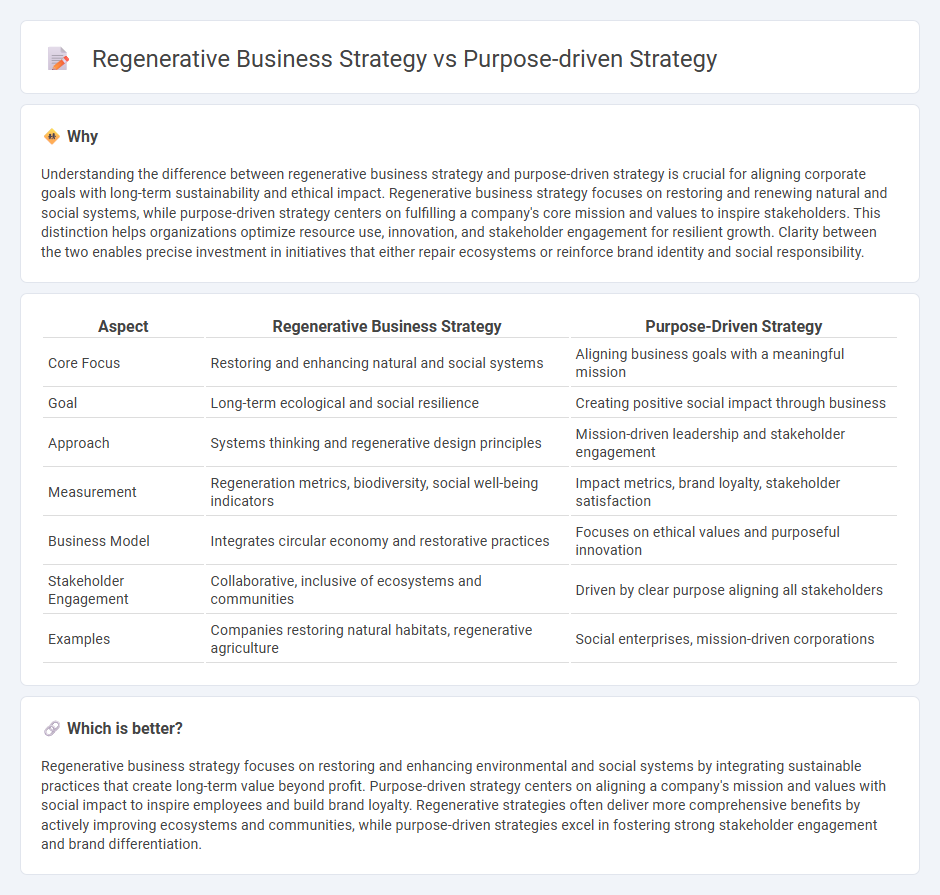
Regenerative business strategy focuses on restoring and revitalizing natural and social systems while delivering economic value, emphasizing long-term resilience and ecosystem health. Purpose-driven strategy centers on aligning a company's mission with societal impact and employee engagement to create meaningful change beyond profits. Explore more to understand how these approaches can transform your organization's impact and growth.
Why it is important
Understanding the difference between regenerative business strategy and purpose-driven strategy is crucial for aligning corporate goals with long-term sustainability and ethical impact. Regenerative business strategy focuses on restoring and renewing natural and social systems, while purpose-driven strategy centers on fulfilling a company's core mission and values to inspire stakeholders. This distinction helps organizations optimize resource use, innovation, and stakeholder engagement for resilient growth. Clarity between the two enables precise investment in initiatives that either repair ecosystems or reinforce brand identity and social responsibility.
Comparison Table
| Aspect | Regenerative Business Strategy | Purpose-Driven Strategy |
|---|---|---|
| Core Focus | Restoring and enhancing natural and social systems | Aligning business goals with a meaningful mission |
| Goal | Long-term ecological and social resilience | Creating positive social impact through business |
| Approach | Systems thinking and regenerative design principles | Mission-driven leadership and stakeholder engagement |
| Measurement | Regeneration metrics, biodiversity, social well-being indicators | Impact metrics, brand loyalty, stakeholder satisfaction |
| Business Model | Integrates circular economy and restorative practices | Focuses on ethical values and purposeful innovation |
| Stakeholder Engagement | Collaborative, inclusive of ecosystems and communities | Driven by clear purpose aligning all stakeholders |
| Examples | Companies restoring natural habitats, regenerative agriculture | Social enterprises, mission-driven corporations |
Which is better?
Regenerative business strategy focuses on restoring and enhancing environmental and social systems by integrating sustainable practices that create long-term value beyond profit. Purpose-driven strategy centers on aligning a company's mission and values with social impact to inspire employees and build brand loyalty. Regenerative strategies often deliver more comprehensive benefits by actively improving ecosystems and communities, while purpose-driven strategies excel in fostering strong stakeholder engagement and brand differentiation.
Connection
Regenerative business strategy and purpose-driven strategy intersect by prioritizing long-term ecological and social impact alongside profitability, integrating sustainability as a core business principle. Both strategies emphasize stakeholder engagement and drive innovation through mission-aligned goals that foster resilience and systemic value creation. This connection enables companies to thrive by addressing environmental challenges while fulfilling meaningful societal purposes.
Key Terms
Mission Alignment
Purpose-driven strategy centers on aligning business activities with a core mission that addresses social or environmental issues, ensuring stakeholder engagement and long-term value creation. Regenerative business strategy goes beyond alignment to actively restore and enhance ecosystems and communities, embedding sustainability into the company's DNA for systemic impact. Explore how integrating mission alignment with regenerative practices can transform business resilience and global impact.
Systems Thinking
Purpose-driven strategies align business goals with social and environmental values, fostering long-term stakeholder engagement. Regenerative business strategies emphasize Systems Thinking by creating feedback loops that restore and enhance natural systems while generating economic value. Explore how integrating Systems Thinking can transform your business into a resilient, future-forward organization.
Stakeholder Value
Purpose-driven strategies prioritize creating value aligned with a company's mission and stakeholder interests, emphasizing long-term social and environmental impact. Regenerative business strategies extend beyond sustainability, aiming to restore and enhance ecosystems and communities while generating economic value for stakeholders. Explore how integrating these approaches can redefine stakeholder value and foster resilient business models.
Source and External Links
What is a Purpose Driven Strategy - Avaans Media - Defines purpose-driven strategy as prioritizing societal, environmental, and community well-being over profits, focusing on employee engagement, external virtue, and measurable impact.
The Purpose-Driven Company: A Playbook for Growth - Jump - Describes purpose-driven companies as those integrating a clear "north star" into strategy and operations to create lasting value beyond financial returns, requiring activated purpose, aligned culture, stakeholder centricity, next-level leadership, and future focus.
The Power of Purpose in Your Business Strategy - Digital Wonderlab - Outlines steps to embed purpose into strategy by clearly defining the intended positive change, aligning culture and operations, integrating sustainability and ethics, communicating transparently, and continually evaluating progress.
 dowidth.com
dowidth.com